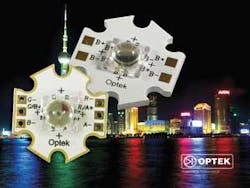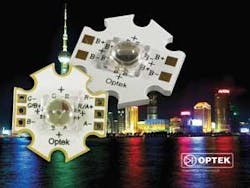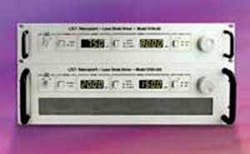IRphotonics offers mid infrared fiber for avionics applications
IRphotonics in Hamden, Conn., is introducing the II-V mid infrared fiber for defense and aerospace applications, such as relatively low-cost, lightweight infrared countermeasures (IRCM) systems. The II-V mid-IR fiber offers a spectral transmission from 0.4 to 5.5 microns with low attenuation and no spectral absorption peak; fiber core diameter from 100 to 200 microns; operating temperature from -20 to 150 degrees Celsius; numerical aperture of 0.10 to 0.25; high damage threshold; and bend insensitivity. For more information, visit IRphotonics online at www.irphotonics.com.
Optek releases low-thermal-resistance LED lights in several colors
TT Electronics Optek Technology in Carrollton, Texas, has developed a star-shaped red/green/blue/amber light-emitting diode (LED) assembly with solid thermal performance by integrating four 1-W LED die into one assembly for solid-state lighting applications. Designated the OV4Z Optimal IV Star Series, the LEDs come in mono-color or RGBA packages and have a recessed die design that houses four LED chips under a 5-millimeter optical-grade water clear lens. The assemblies achieve an extremely low thermal resistance from junction to heatsink. The Optimal IV Star Series assemblies have emitted colors of blue (455–460 nanometers), green (530–535 nanometers), red (620–630 nanometers), amber (585–595 nanometers), and daylight white.
Typical forward voltage at 350 milliamp ranges from 2.5 to 3.9 volts for the RGBA devices, and 8.6 to 13.1 volts for the mono-color assemblies, while luminous flux at 350 milliamp ranges from 5 lm to 36 lm and 29 lm to 162 lm, depending on LED color. Viewing angle for the RGBA and mono-color assemblies is 60 degrees. Maximum allowable junction temperature is 130 degrees Celsius, with an operating temperature range of -50 to 100 C. For more information, visit Optek online at www.optekinc.com.
Newport introduces high-power diode drivers for multi-emitter lasers
Newport Corp. in Irvine, Calif., is announcing the 5700 series high-power laser diode drivers for stacked multi-bar, multi-emitter lasers and laser diodes. The 5700-30-5 (30 amps at 5 volts) and the 5700-80-7 (80 amps at 7.5 volts) models are for use with single-bar multi-emitter laser diodes, while the 5700-100 (100 amps at 30 volts) and 5700-150 (150 amps at 20 volts) are for stacked multi-bar, multi-emitter lasers. The latter models both use a notable 3000-watt power supply for devices in laser research. The 5700 series has continuous wave (CW) or pulsed-current mode of operation with the optional local or remote control. Full LIV characterization of laser diodes is attainable via the USB 2.0 interface; software drivers are provided. Enhanced safety features protect the laser diode during setup mode by preventing incorrect settings, and when the instrument is powered off, program settings are saved in the non-volatile memory.
Comprehensive laser diode protection is provided through a variety of measures: transient filtering, intermittent contact protection, independent current limit and power limit settings, and a slow turn-on sequence. Users may change setup parameters, as needed, to facilitate several test requirements, making these devices for R&D, manufacturing, and quality control. For all signal input/output requirements, including the TTL input and output interlock, current monitor, and voltage monitor, a convenient, single DB25 connector is used. A DB25 connector interlock is also included in the instrument. For more information, visit Newport online at www.newport.com.
Discovery Semiconductors introduces quad photodiode arrays for optical communications
Discovery Semiconductors Inc. in Ewing, N.J., is introducing four-element quad indium gallium arsenide (InGaAs) photodiode arrays for 40- and 100-gigabit-per-second optical communications. The Quad PD Arrays consist of four photodiodes monolithically integrated on a common indium phosphide (InP) substrate, and are fabricated using a low FIT rate InGaAs/InP semiconductor process. The Quad PD Array consists of either 10-, 30-, 40-, or 50-micron diameter photodiodes. The individual RF bandwidth of the photodiodes is 10, 15, 20, or 40 GHz. The top illuminated photodiodes work for 1.3-micron as well as 1.5-micron based communication systems. The optical power handling of each photodiode exceeds +12dBm for coherent systems requiring high optical LO power. The target applications include 100-gigabit-per-second long-haul pol-mux (D)QPSK, 40-gigabit-per-second long-haul (D)QPSK, and 40G/100G parallel networking. The Quad PD Array can be configured as a 4-channel receiver or as a 4-channel balanced receiver using two arrays. The Quad PD Array is available as a module with single-mode fiber pigtails with GPPO or coplanar waveguide RF outputs, and is available with or without integrated transimpedance amplifiers. For additional information, visit Discover Semiconductors online at www.chipsat.com.


